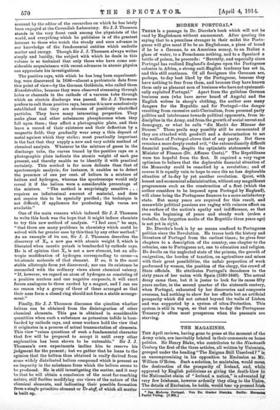SIR J. J. THOMSON'S RESEARCHES:t
Tits first volume of Messrs. Longmane' promising series of "Monographs on Physics" is fittingly devoted to an • Fanny on Truth and Boality. By P. H. Bradley. Ozford: at the Clarendon Pron. [lac dd. net t Bars of Positloo Bloctriedy. By Sir I. I. Thomson. London( Landau& and Co. De Bata account by the editor of the researches on which he has lately been engaged at the Cavendish Laboratory. Sir J. 3. Thomson stands in the very front rank among the physicists of the world, and everything which he publishes is of the greatest interest to those who watch the steady and sure advance in our knowledge of the fundamental entities which underlie matter and energy. Though. SirJ. J. Thomson always writes simply and lucidly, the subject with which he deals in this volume is so technical that only those who have some con- siderable acquaintance with recent advances in atomic physics can appreciate his investigations. The positive rays, with which he has long been experiment- ing, were discovered in 1886—almost a prehistoric date from this point of view—by the German Goldstein, who called them Sanelava hien, because they were observed streaming through holes or channels in the cathode of a vacuum tube through which an electric: discharge was passed. Sir J. J. Thomson prefers to call them positive rays, because it is now conclusively established that they are streams of positively electrified particles. They have many interesting properties. They make glass and other substances phosphoresce when they fall upon them; they affect a photographic plate, and thin leave a record of their existence and their deflection by a magnetic field; they gradually wear away a thin deposit of metal against which they strike; most practically important is the fact that they supply a new and very subtle method of chemical analysis. Whatever be the mixture of gases in the discharge tube, the curves traced by the positive rays on a photographic plate indicate the atomic weight of each gas present, and thereby enable us to identify it with practical certainty. This method is far more delicate than that of spectroscopic analysis; for instance, it enables us to detect the presence of one per cent. of helium in a mixture of helium and hydrogen, whereas the spectroscope would only reveal it if the helium were a considerable percentage of the mixture. " The method is surprisingly sensitive . . . requires an infinitesimal amount of material, and does not require this to be specially purified; the technique is not difficult, if appliances for producing high vacua are available."
One of the main reasons which induced Sir P. J. Thomson to write this book was the hope that it might induce chemists to try this new method of analysis. "I feel sure," be says, " that there are many problems in chemistry which could be solved with far greater ease by this than by any other method." As an example of its use, Sir J. J. Thomson describes the . discovery of X, a new gas with atomic weight 3, which is liberated when caustic potash is bombarded by cathode rays. He is of opinion that X3 is not a new element, but an allo- tropic modification of hydrogen corresponding to ozone—a tri-atomic molecule of that element. If so, it is the most stable allotropic form yet discovered; nor can its existence be reconciled with the ordinary views about chemical valency. "If, however, we regard an atom of hydrogen as consisting of a positive nucleus and one negative corpuscle, it will exert forces analogous to those excited by a magnet, and I can see no reason why a group of three of these arranged so that their axe', form a closed ring should not form a stable arrange- ment."
Finally, Sir J. J. Thomson discusses the qiiestion whether helium can be obtained from the disintegration of other chemical elements. This gas is obtained in considerable quantities when such a substance as potassium iodide is 'bom- barded by cathode rays, and some workers hold the view that it originates in a process of actual transmutation of elements. This view "raises questions of such a fundamental character that few will be prepared to accept it until every other explanation has been shown to be untenable." Sir J. J. Thoauson'a own experiments incline him to reserve his judgment for the present; but we gather that be leans to the opinion that the helium thus obtained is really derived from tome widely distributed helium compound which is present as en impurity in the anbatance from which the helium seems to be produeed.-_ He is still investigating the matter, and it may be that he will obtain a conclusion of the most far-reaching natal% still further modifying our views of the nature of the chemical elements, and indicating their possible formation from asingle primitive element or Urittoff, of which all matter is Wilt up.















































 Previous page
Previous page